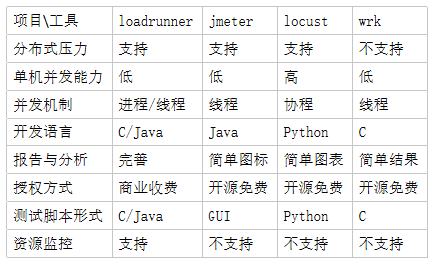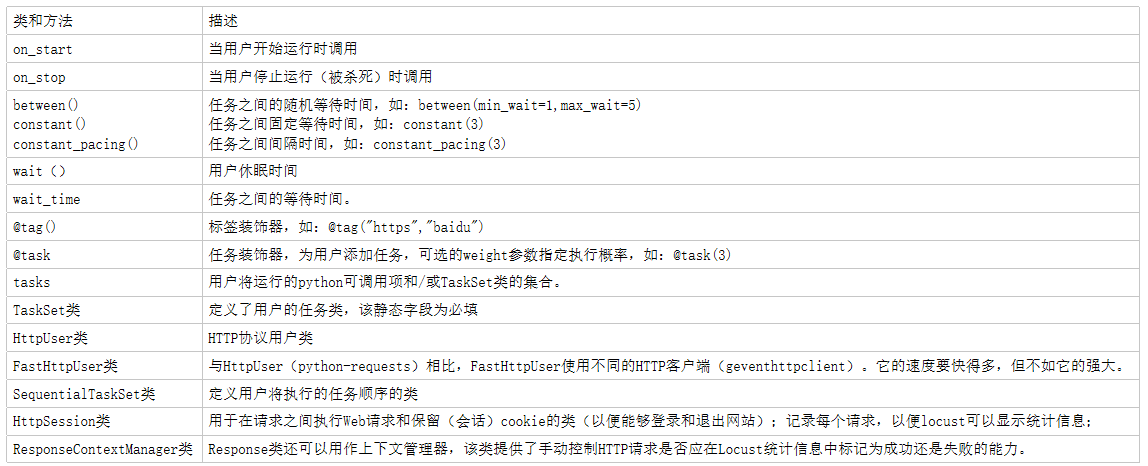一、Locust工具介绍
1.概述
Locust是一款易于使用的分布式负载测试工具,完全基于事件,使用python开发,即一个locust节点也可以在一个进程中支持数千并发用户,不使用回调,通过gevent使用轻量级过程(即在自己的进程内运行)。
2.常见性能测试工具比较

3.环境搭建
Python3.7.9
源码安装:下载源码https://github.com/locustio/locust,进入文件夹执行安装命令:python setup.py install
pip安装:pip install locust==1.4.3
二、Locust常用类和方法
三、Locust常用参
四、案例
1.参数化
# -*- coding: utf-8 -*- import os,random from locust import TaskSet, task,HttpUser, between #任务类 class Testlocust(TaskSet): def on_start(self): self.login_headers={'x-client-id': 'xxxxxx'} #头文件 self.data=[ { "account_name": "登录账号1", "user_name": "登录账号1", "hashed_password": "登录密码1" }, { "account_name": "登录账号2", "user_name": "登录账号2", "hashed_password": "登录密码2" }, { "account_name": "登录账号3", "user_name": "登录账号3", "hashed_password": "登录密码3" } ] #登录账号密码 print("------on start------") @task() def userlogin(self): r = self.client.post(url='/v1/auth/users/login', headers=self.login_headers,json=random.choice(self.data),name='登录',verify=False) #使用choice方法参数化随机登录 assert r.status_code == 200 and r.json()['status']==0 #登录断言 def on_stop(self): print("------on stop------") #用户类 class WebsiteUser(HttpUser): #locust1.0版本以前是HttpLocust tasks = [Testlocust] #locust1.0版本以前是task_set=Testlocust host = 'https://xxxxxx' #被测主机地址 wait_time = between(min_wait=1,max_wait=5) #任务之间的等待时间 if __name__ == "__main__": os.system("locust -f locust_XX.py") #执行locust脚本
2.关联
# -*- coding: utf-8 -*- import os,requests from locust import TaskSet, task,HttpUser, between #任务类 class Testlocust(TaskSet): def on_start(self): print("------on start------") access_token = self.userlogin() #返回登录token self.headers = {} #定义headers self.headers['x-api-key'] = 'fZkQSHC1dp2s0tL21EMtaNX3UjF7P6L9' #添加headers值 self.headers['Authorization'] = 'Bearer ' + access_token self.headers['x-key-hash'] = '1607675936446;abcdefg;bca1ef2b5835e454a15929f7ce9cb5d7ebaf580377624019002' self.headers['Content-Type'] = 'application/json' self.params = {"name": "CDR", "page": "1", "size": "10", "series": "CDR80"} #查询接口参数 def userlogin(self): #登录方法 login_url = 'https://xxxxxx/v1/auth/users/login' #登录url data = { "account_name": "账号1", "user_name": "账号1", "hashed_password": "密码1" } #登录账号密码 login_headers = {'x-client-id': '46bf882df2959ea2'} r = requests.request('POST', url=login_url, headers=login_headers, json=data) #登录 return r.json()['access_token'] #返回登录token @task() def search(self): #查询设备信息 r = self.client.get(url='/v1/assets/device/search', headers=self.headers,params=self.params, name='查询', verify=False) #查询 assert r.status_code == 200 and r.json()['code'] == 0 #结果断言 #用户类 class WebsiteUser(HttpUser): #locust1.0版本以前是HttpLocust tasks = [Testlocust] #locust1.0版本以前是task_set=Testlocust host = 'https://xxxxxx.com' #被测主机地址 wait_time = between(min_wait=1,max_wait=5) #任务之间的等待时间 if __name__ == "__main__": os.system("locust -f locust_XX.py") #执行参数